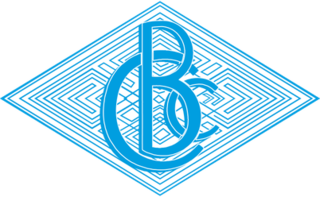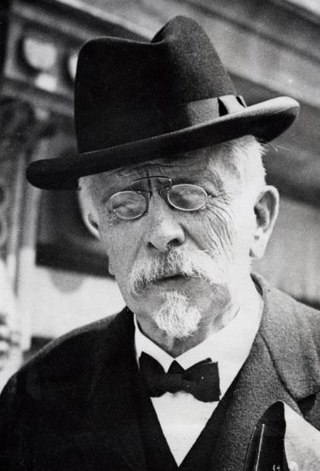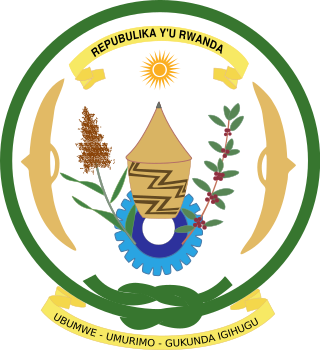

This article lists the colonial residents of Rwanda, during the time when modern-day Rwanda was part of German East Africa and Ruanda-Urundi.


This article lists the colonial residents of Rwanda, during the time when modern-day Rwanda was part of German East Africa and Ruanda-Urundi.
(Dates in italics indicate de facto continuation of office)
| Tenure | Portrait | Incumbent | Notes |
|---|---|---|---|
| German suzerainty | |||
| 1897 to 1907 | the Residents in Urundi | ||
| August 1907 to 1911 |  | Richard Kandt , Resident | 1st term |
| 1911 to 1913 | Eberhard Gudowius , acting Resident | ||
| 1913 to 1914 |  | Richard Kandt , Resident | 2nd term |
| 1914 to 17 May 1916 | Max Wintgens , acting Resident | ||
| 17 May 1916 to 17 June 1916 | ... Scharpes, Resident | ||
| Belgian suzerainty | |||
| 27 June 1916 to 30 April 1917 | Gustave Eugène Henri Stevens , Military Resident | ||
| 30 April 1917 to December 1918 | Gérard François Declerck , Military Resident | ||
| 4 February 1919 to 5 May 1919 | Georges Mortehan , Resident | 1st term | |
| 5 May 1919 to 1920 | Edouard van den Eende , Resident | ||
| 1920 to 28 November 1923 | Georges Mortehan , Resident | 2nd term | |
| 1924 to 18 February 1925 | Oger Coubeau , Resident | 1st term | |
| 1925 to 1926 | ... Keyser, acting Resident | ||
| 1926 to 15 September 1928 | Georges Mortehan , Resident | 3rd term | |
| September 1928 to 14 April 1929 | Oger Coubeau , acting Resident | 2nd term | |
| 14 April 1929 to 14 September 1929 | Georges Mortehan , Resident | 4th term | |
| 14 September 1929 to 8 January 1930 | H. Wilmin, Resident | ||
| 8 January 1930 to 18 December 1932 | Oger Coubeau , Resident | 3rd term | |
| 19 December 1932 to 1 March 1935 | Maurice Simon , Resident | 1st term | |
| 1 March 1935 to 1 October 1935 | ... Hombart, Resident | ||
| 1 October 1935 to 1 August 1938 | Maurice Simon , Resident | 2nd term | |
| 1 August 1938 to 24 January 1939 | Albert Gille , Resident | ||
| 24 January 1939 to 9 September 1940 | Maurice Simon , Resident | 3rd term | |
| 9 September 1940 to 15 April 1942 | Jean Paradis , Resident | 1st term | |
| 15 April 1942 to 1 July 1942 | Léon Grauls , Resident | 1st term | |
| 1 July 1942 to 21 September 1942 | Maurice Simon , Resident | 4th term | |
| 21 September 1942 to 15 April 1943 | Léon Grauls , Resident | 2nd term | |
| 15 April 1943 to 1 November 1943 | Jean Paradis , Resident | 2nd term | |
| 1 November 1943 to 1 December 1943 | Léon Grauls , Resident | 3rd term | |
| 1 December 1943 to 24 January 1944 | Jean Paradis , Resident | 3rd term | |
| 24 January 1944 to 27 February 1944 | Léon Grauls , Resident | 4th term | |
| 27 February 1944 to 31 March 1945 | George Victor Sandrart , Resident | 1st term | |
| 31 March 1945 to 4 August 1945 | Léon Grauls , Resident | 5th term | |
| 4 August 1945 to 19 March 1947 | George Victor Sandrart , Resident | 2nd term | |
| 19 March 1947 to 4 August 1947 | Daniel Vauthier , Resident | ||
| 4 August 1947 to 21 January 1948 | Marcel Édouard Antoine Dessaint , Resident | 1st term | |
| 28 January 1948 to 27 January 1951 | George Victor Sandrart , Resident | 3rd term | |
| 27 January 1951 to 1957 | Marcel Édouard Antoine Dessaint , Resident | 2nd term | |
| 1954 | ... Bourgeois, acting Resident | Acting for Dessaint | |
| 1957 to 11 November 1959 | André Preud'homme , Resident | ||
| 11 November 1959 to January 1962 | Guillaume "Guy" Logiest , Special Military Resident | Appointed following the outbreak of the Rwandan Revolution | |
| January 1962 to 1 July 1962 | Guillaume "Guy" Logiest , High Representative | ||
| 1 July 1962 | Independence as Republic of Rwanda | ||

Ruanda-Urundi, later Rwanda-Burundi, was a colonial territory, once part of German East Africa, which was occupied by troops from the Belgian Congo during the East African campaign in World War I and was administered by Belgium under military occupation from 1916 to 1922. It was subsequently awarded to Belgium as a Class-B Mandate under the League of Nations in 1922 and became a Trust Territory of the United Nations in the aftermath of World War II and the dissolution of the League. In 1962 Ruanda-Urundi became the two independent states of Rwanda and Burundi.

This article lists the prime ministers of Rwanda since the formation of the post in 1961, to the present day.

The Central Bank of the Congo is the central bank of the Democratic Republic of the Congo. The bank's main offices are on Boulevard Colonel Tshatshi in La Gombe in Kinshasa.
Eugène Jungers (1888–1958) was a Belgian colonial civil servant and lawyer. Beginning his career in the Belgian Congo as a colonial magistrate, Jungers rose rapidly through the judiciary and became the colonial governor of the League of Nations Mandate of Ruanda-Urundi from 1932 to 1946. In 1946, Jungers was further promoted to Governor-General of the Belgian Congo, the senior administrative position in the colony, which he held from 1946 to 1952.
The Ruanda-Urundi franc was a currency issued for the Belgian mandate territory of Ruanda-Urundi in 1960–62 which continued to circulate within its successor states of Rwanda and Burundi until 1964. The currency replaced the Belgian Congo franc which had also circulated in Ruanda-Urundi from 1916–60 when the Belgian Congo became independent, leaving Ruanda-Urundi as the sole Belgian colonial possession in Africa. With the independence of Rwanda and Burundi in 1962, the shared Ruanda-Urundi franc continued to circulate until 1964 when it was eventually replaced by two separate national currencies.
Joseph Cimpaye was a Burundian politician and writer.

The Belgian Minister of the Colonies was a Belgian parliamentarian who was responsible for the territories of the colonial empire in Central Africa from 1908 to 1962, comprising the colony of the Belgian Congo (1908–60) and the international mandate of Ruanda-Urundi (1916–62). The exact title was changed on several occasions.

This is a survey of the postage stamps and postal history of Rwanda. The Republic of Rwanda is a landlocked country located in the Great Lakes region of eastern-central Africa, bordered by Uganda, Burundi, the Democratic Republic of the Congo and Tanzania.
The Ruzagayura famine was a major famine which occurred in the Belgian mandate of Ruanda-Urundi during World War II. It led to numerous deaths and a huge population migration out of the territory and into the neighboring Belgian Congo and surrounding areas. The famine is considered to have begun in October 1943 and ended in December 1944.

The African territories of Ruanda and Urundi came under Belgian control as Ruanda-Urundi after they were seized from Germany during World War I in 1916. They had previously formed part of German East Africa.

Jean-Paul Harroy was a Belgian colonial civil servant who served as the last Governor and only Resident-General of Ruanda-Urundi. His term coincided with the Rwandan Revolution and the assassination of the popular Burundian political leader Prince Louis Rwagasore. It has been alleged that Harroy may have been implicated in the murder.
Louis Joseph Postiaux was a Belgian colonial administrator who was governor of Ruanda-Urundi, and then governor of Katanga Province.
Maurice Simon was a Belgian colonial administrator.

Belgium-Rwanda relations refers to the international and diplomatic relations between Belgium and Rwanda. Belgian relations with Rwanda started under the League of Nations mandate, when the modern day countries of Rwanda and Burundi were governed as Ruanda-Urundi. As the colonial power, Rwanda's relationship with Belgium has been significant throughout the country's history, even after independence.
In the Rwandan Revolution, the coup of Gitarama was an event which occurred on 28 January 1961 in which the monarchy in Rwanda, then a part of the Belgian mandate of Ruanda-Urundi, was abolished and replaced with a republican political system. The traditional monarchy was led by a Mwami (king), who ruled through an administration of chiefs and subchiefs in the context of a feudal system of patron-client relations based on tribute. The Mwami and most of his chiefs were members of the Tutsi ethnic minority, a group which wielded considerable social, political economic power. Of subordinate status to the Tutsis was the Hutu ethnic majority. As part of their rule, the Belgians institutionalised a racial hierarchy which favoured the Tutsis at the expense of the Hutus.

Rwandan nationality law is regulated by the Constitution of Rwanda, as amended; the Nationality Code of Rwanda, and its revisions; the Law of Persons and Family; and various international agreements to which the country is a signatory. These laws determine who is, or is eligible to be, a national of Rwanda. The legal means to acquire nationality, formal legal membership in a nation, differ from the domestic relationship of rights and obligations between a national and the nation, known as citizenship.

Germany–Rwanda relations are good and there is a "close and pragmatic" relationship between the two countries, according to the German Foreign Office. In the 21st century, Germany is one of the most important donors of development aid to Rwanda.